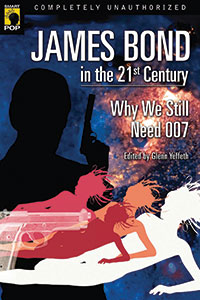Savagely, the Valkyrs closed with them, and the air rang with the metallic clash of steel. No mercy was asked and none was given. Kieron cut a circle of death with his long, outworld weapon, the fighting blood of a hundred generations of warriors singing in his ears. The savage chant of the Edge rose above the confused sounds of battle… Okay, everyone got that? The Valkyrs are savages. Are we all clear on this point? Good.
I’ve been making a study of interstellar empires in science fiction lately. Why is something I will talk about another time, but for this study I’ve been delving into my ludicrously large personal library and pulling lots of books I’d forgotten I had off the shelves. I probably should downsize the library one of these days. If there’s an obscure book from the 1950s through the 1980s that you’re looking for, let me know. I probably have a copy I’d be happy to part with.
My primary source for this research, though, has been
Galactic Empires, the massive two-volume hardcover anthology that Brian Aldiss put together in the mid-1970s in an attempt to do a comprehensive survey of the subject. Some of the stories in this collection are brilliant: for example, “Brightness Falls from the Air” by Idris Seabright (Margaret St. Clair) or “All the Way Back” by Michael Shaara. (See
“Michael Shaara: Wishing for the Killer Aliens” by Guy Stewart.)
Others range from being merely embarrassing to downright awful now, with the worst so far being “Foundation” by Isaac Asimov. No, not the heavily edited and revised first novel, but the very first short story in the series, as published in Astounding in 1951. For starters, it isn’t even a story. It’s a history lecture that segues into a talky vignette with a few two-dimensional characters, and then doesn’t so much end as just sort of come to a stop in mid-air. While not Exhibit A, this story definitely would be one of the primary exhibits I would cite in making the case that John Campbell’s long tenure at Astounding was on the whole very bad for science fiction as a genre.
But this too is an argument for another time. Today I want to focus on The Rebel of Valkyr, by Alfred Coppel, a 1950 short novel that I stayed up reading way too late last night—not because I was hooked on the story, but because I wanted to finish the damned thing, so that I could check it off my list and move on.
I found The Rebel of Valkyr to be perversely fascinating. If you want to read it, it’s in the public domain now, and there are plenty of places where you can find it: for example, on Project Gutenberg, or on Comic Book +, a facsimile site that can easily turn into an enormous time-sink. I found the original cover art on ayay, another site that along with PulpCovers.com could easily chew up the rest of your day if you let it. Hell, I could publish an edition of The Rebel of Valkyr if I wanted to, which is the sort of temptation that can only be dispelled by making the Sign of the Cross and saying, “Get thee behind me, Campbell.”
But to get back to the book…
[SPOILER ALERT!]
The Rebel of Valkyr delivers just what it promises: a formulaic quasi-Medieval swords-and-princesses romance, only with starships and planets instead of sailing ships and kingdoms. The prologue (yes, it has a prologue) explains that a new barbaric empire has grown up in the ruins of the First Terran Empire. Ancient starships remain operational, but no one understands how they work, only that they do. (I suppose if you’re going to solve the problem of FTL travel using FM, you may as well go whole-hog and make it real FM to your characters.) Other ancient technologies remain in dark places, but the people who study and try to use those technologies are reviled and hunted as witches and warlocks, as their evil magic is blamed for bringing about the fall of the First Empire and the new Dark Ages. (Does this begin to sound familiar?)
Our hero is Kieron of Valkyr: for all practical purposes a space viking. The babe on the cover is his love interest, the beautiful Princess Alys, daughter of the beloved and recently deceased Emperor Gilmer and rightful heir to the throne. Alys actually spends most of the novel running around half-naked, as topless gowns are in fashion in the Imperial court this year, but I suppose in 1950 Planet Stories didn’t dare put that on the cover. The villain is Alys’s wicked and scheming stepmother—oh, she has some other title, but that’s what Lady Ivane amounts to; a Disney princess’s wicked stepmother—and after that we have a large cast of extras, most of whom behave exactly like movie extras, right down to not even bothering to have names or make noise when they die.
There are plots; machinations; hairsbreadth escapes; stupid and obvious traps the heroes fall into nonetheless; the eventual reveal, telegraphed well in advance, that Grima Wormtongue—excuse me, Freka the Unknown—is actually an android, and that Lady Ivane’s treacherous right-hand man is in fact the very embodiment of evil forbidden technology, which means that by extension she’s a witch—
In the penultimate dramatic scene Princess Alys finally gets some clothes on and rides into the scene on a white horse, wearing her steel battle panties, a chain mail hauberk, and a freakin’ winged helmet, thus causing the opposing army to instantly accept her as the rightful heir to the throne and change sides…
[LARS: You want proof she’s the rightful heir to the throne? Check out that hauberk!
[OLAF: Dude, I’ll pledge allegiance to those breasts any day of the week and twice on Sunday!]
And yes, of course, the plot climaxes with a sword fight in the throne room, as all the extras stand back respectfully and give Kieron and Freka room to settle with swords the question of who is the rightful Empress of the Galaxy.
Yeah, wonderfully romantic. Totally nonsensical. I would have loved this story when I was twelve.
___________________
My curiosity engaged, I decided to do more research. Alfred Coppel (real name: Alfredo Jose de Arana-Marini Coppel) turns out to have been a fascinating character. A World War II fighter pilot and combat vet, after he was discharged he took up writing fiction, and under a stable of pseudonyms was an incredibly prolific writer from the late 1940s right up through the 1990s. While best known in the insular and introverted world we call the science fiction community for the pulp sci-fi he wrote in the 1940s and 1950s, he wrote all kinds of material, for all kinds of markets, and apparently had his greatest commercial success as a writer of mainstream military thrillers in the 1970s.
As I said, part of the challenge in figuring out what he wrote is that he worked under a bevy of pseudonyms. For example, I have on my desk right now a copy of The Sentinel Stars, by Louis Charbonneau, which I picked out of a thrift store used-book bin because I thought the cover looked liked a good candidate for my Gallery of Awful Cover Art and then was hooked by the tag line on the jacket copy: “THE SENTINEL STARS—a novel of our world run as the Bureau of Internal Revenue would run it!”
Imagine my surprise at learning that “Louis Charbonneau” too was actually Alfredo Coppel.
I meet a lot of writers who seem to think you can make a living and a lifelong career out of writing nothing but science fiction. That’s a nice dream, and I have known a very small number of people who actually managed to do it, but a career like Coppel’s is more common. Don’t let yourself get pigeonholed. Read omnivorously. Try to write in other genres. Know that the winds of literary fashion are extraordinarily fickle, and be prepared to become someone else should the need arise.
~brb



















































